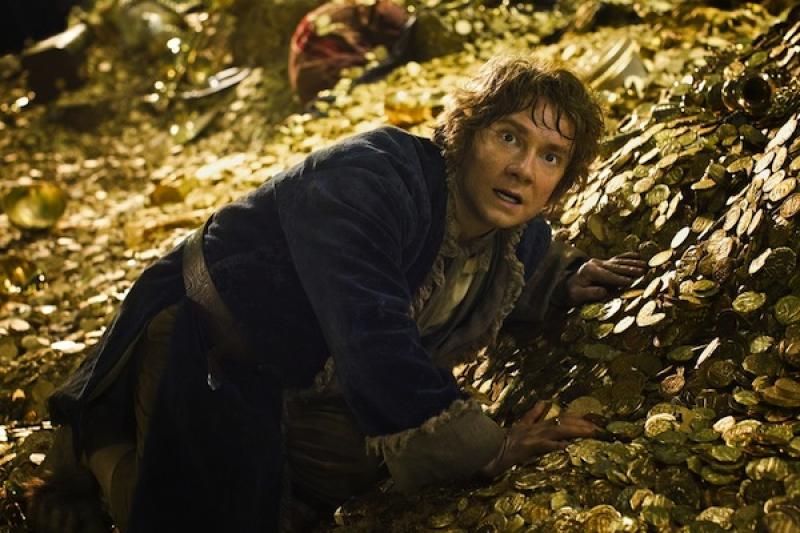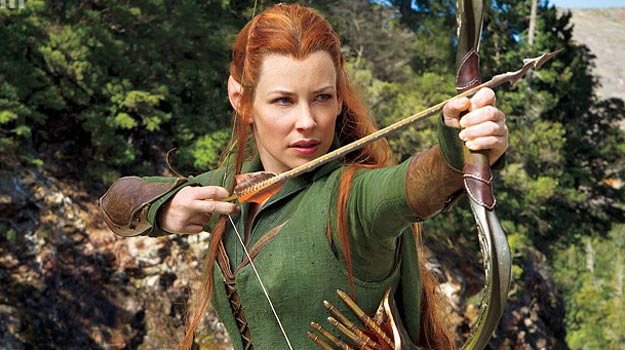The Hobbit: The Desolation of Smaug | reviews, news & interviews
The Hobbit: The Desolation of Smaug
The Hobbit: The Desolation of Smaug
Epic adventure improves on 'An Unexpected Journey' but is spoiled by the PlayStation aesthetic

Unless Peter Jackson and his team decide to mine The Silmarillion for three more J.R.R. Tolkien adaptations, their films of The Lord of the Rings and The Hobbit will, by this time next year, comprise a complete hexalogy – or, at least, two consecutive triptychs.
This is not proving the case. Now that The Hobbit: The Desolation of Smaug brings audiences to the brink of the final chapter, Bilbo Baggins's journey is looking less like the spiritual antecedent (and the cause) of Frodo's more momentous odyssey than a blueprint for mindless gaming. On one hand, stylistic, tonal, and pictorial fissures have opened up in the series; on the other, the use of recurrent motifs is becoming stale.
A consequence of the blanket application of CGI is the sidelining of that old movie staple, acting
The logic that The Lord of the Rings was an adult tale that would also appeal to young people on the big screen paid off artistically as well as commercially. The logic that The Hobbit is a children's book best suited for the kind of kids' action-adventure cinema that would attract millions of adults hooked on 3D spectacles is also making a mint. As a serious evocation of Middle-earth, however, the second triptych is failing because it is being forced away from Tolkien's bardic sensibility by the calculated imposition of a PlayStation aesthetic.
The most blatant example of the video-game effect in last year's An Unexpected Journey was Bilbo (Martin Freeman) and the dwarves' perilous flight from the orcs on a series of suspended rope-and-board walkways in Moria. It is echoed twice in The Desolation of Smaug: first when Bilbo frees his companions from an elvish prison in the diseased forest of Mirkwood and they career downriver in barrels under orc attack; second when they are pursued by the dragon Smaug (voiced by Benedict Cumberbatch) in the labyrinths of Erebor, their ancestral home under the Lonely Mountain, which they seek to reclaim along with their coveted treasure. This inflated concluding sequence mars a movie that's otherwise more charged and gripping than its predecessor.
 Here and there, Jackson has drenched it in the sublime ominousness he brought to Frodo's quest. If Tolkien had lived to see The Lord of the Rings films, I can't imagine he wouldn't have appreciated the dread first appearances of the mounted Ringwraiths, their attack on Weathertop, the Fellowship's approach to the great pillars at Argonauth on the River Anduin, and the crossing of the Dead Marshes. Similarly, he might have admired the eerie scenes in The Desolation of Smaug that show Gandalf (Ian McKellen) and Radagast (Sylvester McCoy) recceing the Gothic fastness Dol Guldur, or the materialisation there of the Necromancer (the future Sauron) as a black mist briefing his reptilian Orc warlords.
Here and there, Jackson has drenched it in the sublime ominousness he brought to Frodo's quest. If Tolkien had lived to see The Lord of the Rings films, I can't imagine he wouldn't have appreciated the dread first appearances of the mounted Ringwraiths, their attack on Weathertop, the Fellowship's approach to the great pillars at Argonauth on the River Anduin, and the crossing of the Dead Marshes. Similarly, he might have admired the eerie scenes in The Desolation of Smaug that show Gandalf (Ian McKellen) and Radagast (Sylvester McCoy) recceing the Gothic fastness Dol Guldur, or the materialisation there of the Necromancer (the future Sauron) as a black mist briefing his reptilian Orc warlords.
The reheating of ideas from The Lord of the Rings smacks occasionally of writers' weariness. The re-introduction of Legolas (Orlando Bloom), absent from The Hobbit book, and the introduction of the elf maiden Tauriel (the thoroughly modern Evangeline Lilly, pictured above), there to lure the Katniss crowd with some girl power, will annoy purists but they add humor. Asking Glóin (Peter Hambleton) about the identity of the ugly boy pictured on a miniature painting in his wallet, Legolas is told that it's the dwarf's son, Gimli – his pugnacious future comrade in arms. The growing love between the beardless dwarf Kili (Aidan Turner, pleasing) and Tauriel satisfies the same need for a rapprochement between their races, as the short-changed courtship of Eowyn and Faramir united two tribes of men in The Return of the King film. Physical healing plays its part in both romances, though Tauriel's joke about Kili's potentially small member is a Middle-earth first.
 The dynamic between the venal Master of Lake Town (Stephen Fry, pictured left) and his snide civil servant Alfrid (Ryan Gage), another newcomer, meanwhile recalls that of Saruman and Grima Wormtongue. Jackson's shifts in subjectivity make the disorienting of the dwarves when they enter Mirkwood one of the film's most disturbing sequences. It sets up their vulnerability to the spider attack which, though indispensable, seems rushed and lacks the menace of Shelob's stalking, stinging, and cocooning of Frodo in the Cirith Ungol pass.
The dynamic between the venal Master of Lake Town (Stephen Fry, pictured left) and his snide civil servant Alfrid (Ryan Gage), another newcomer, meanwhile recalls that of Saruman and Grima Wormtongue. Jackson's shifts in subjectivity make the disorienting of the dwarves when they enter Mirkwood one of the film's most disturbing sequences. It sets up their vulnerability to the spider attack which, though indispensable, seems rushed and lacks the menace of Shelob's stalking, stinging, and cocooning of Frodo in the Cirith Ungol pass.
A further consequence of the blanket application of CGI is the sidelining of that old movie staple, acting. Deprived of dialogue, Freeman and McKellen rely on rote ironic asides and mannered glances. Richard Armitage is unsubtle as Thorin, the blustering dwarf king-in-waiting, as is Lee Pace as Thranduil, the supercilious Elvenking. Luke Evans gives the film's most arresting performance as Bard, the Lake Town waterman, archer, and single father, who emerges as the beleaguered region's working-class hero.
If I were a 10-year-old who had never read The Hobbit or had it read to him, I might dismiss the above objections as joylessly pedantic. As a long-retired member of the Tolkien Society who bought into the dream in the mid-1970s, I resent seeing it desecrated by the opportunists who are cashing in on the multi-platforming of Bilbo's and Frodo's adventures. I don't doubt the integrity of Jackson, his co-writers Fran Walsh and Philippa Boyens, and their visual collaborators in trying to do their best by the books. But – for all the The Hobbit films' felicities, not least the graphic designers' gnarled, creaturely trees and those vertiginous edifices and vaults – there's something rotten in the digital Midde-earth.
Overleaf: watch the trailer to The Hobbit
rating
Explore topics
Share this article
The future of Arts Journalism
You can stop theartsdesk.com closing!
We urgently need financing to survive. Our fundraising drive has thus far raised £49,000 but we need to reach £100,000 or we will be forced to close. Please contribute here: https://gofund.me/c3f6033d
And if you can forward this information to anyone who might assist, we’d be grateful.

Subscribe to theartsdesk.com
Thank you for continuing to read our work on theartsdesk.com. For unlimited access to every article in its entirety, including our archive of more than 15,000 pieces, we're asking for £5 per month or £40 per year. We feel it's a very good deal, and hope you do too.
To take a subscription now simply click here.
And if you're looking for that extra gift for a friend or family member, why not treat them to a theartsdesk.com gift subscription?
more Film
 Can I get a Witness? review - time to die before you get old
Ann Marie Fleming directs Sandra Oh in dystopian fantasy that fails to ignite
Can I get a Witness? review - time to die before you get old
Ann Marie Fleming directs Sandra Oh in dystopian fantasy that fails to ignite
 Happyend review - the kids are never alright
In this futuristic blackboard jungle everything is a bit too manicured
Happyend review - the kids are never alright
In this futuristic blackboard jungle everything is a bit too manicured
 Robert Redford (1936-2025)
The star was more admired within the screen trade than by the critics
Robert Redford (1936-2025)
The star was more admired within the screen trade than by the critics
 Blu-ray: The Sons of Great Bear
DEFA's first 'Red Western': a revisionist take on colonial expansion
Blu-ray: The Sons of Great Bear
DEFA's first 'Red Western': a revisionist take on colonial expansion
 Spinal Tap II: The End Continues review - comedy rock band fails to revive past glories
Belated satirical sequel runs out of gas
Spinal Tap II: The End Continues review - comedy rock band fails to revive past glories
Belated satirical sequel runs out of gas
 Downton Abbey: The Grand Finale review - an attemptedly elegiac final chapter haunted by its past
Noel Coward is a welcome visitor to the insular world of the hit series
Downton Abbey: The Grand Finale review - an attemptedly elegiac final chapter haunted by its past
Noel Coward is a welcome visitor to the insular world of the hit series
 Islands review - sunshine noir serves an ace
Sam Riley is the holiday resort tennis pro in over his head
Islands review - sunshine noir serves an ace
Sam Riley is the holiday resort tennis pro in over his head
 theartsdesk Q&A: actor Sam Riley on playing a washed-up loner in the thriller 'Islands'
The actor discusses his love of self-destructive characters and the problem with fame
theartsdesk Q&A: actor Sam Riley on playing a washed-up loner in the thriller 'Islands'
The actor discusses his love of self-destructive characters and the problem with fame
 Honey Don’t! review - film noir in the bright sun
A Coen brother with a blood-simple gumshoe caper
Honey Don’t! review - film noir in the bright sun
A Coen brother with a blood-simple gumshoe caper
 The Courageous review - Ophélia Kolb excels as a single mother on the edge
Jasmin Gordon's directorial debut features strong performances but leaves too much unexplained
The Courageous review - Ophélia Kolb excels as a single mother on the edge
Jasmin Gordon's directorial debut features strong performances but leaves too much unexplained
 Blu-ray: The Graduate
Post #MeToo, can Mike Nichols' second feature still lay claim to Classic Film status?
Blu-ray: The Graduate
Post #MeToo, can Mike Nichols' second feature still lay claim to Classic Film status?

Add comment